Oliver headed off to grade 8 at Birchwood this morning; Ethan’s not ready to stay in school with him during the day, but he walks to school with us every morning. Off they go! (My archive isn’t complete, but recent years are there; and the first one).
Grade Eight, 2014
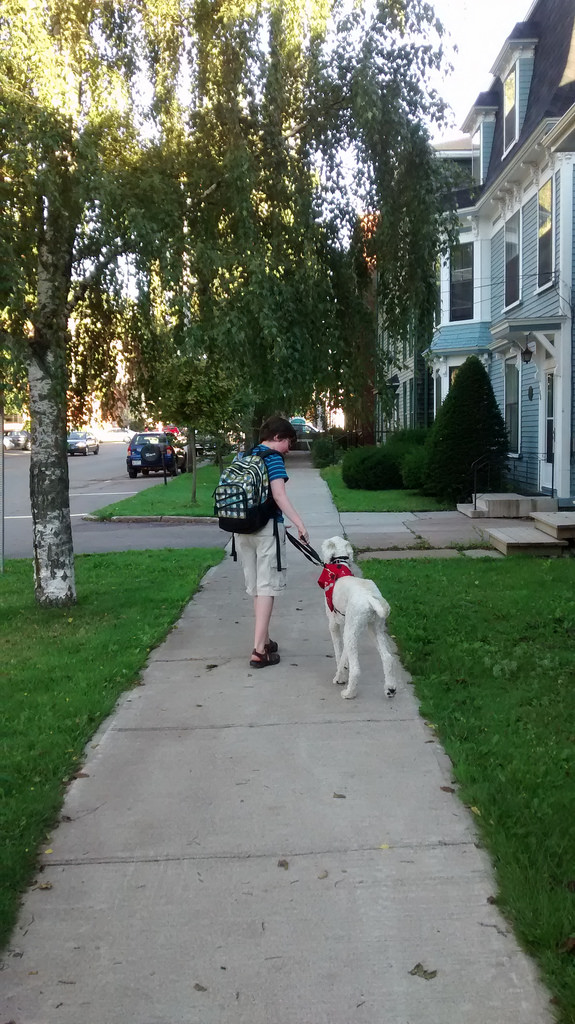
Grade Seven, 2013
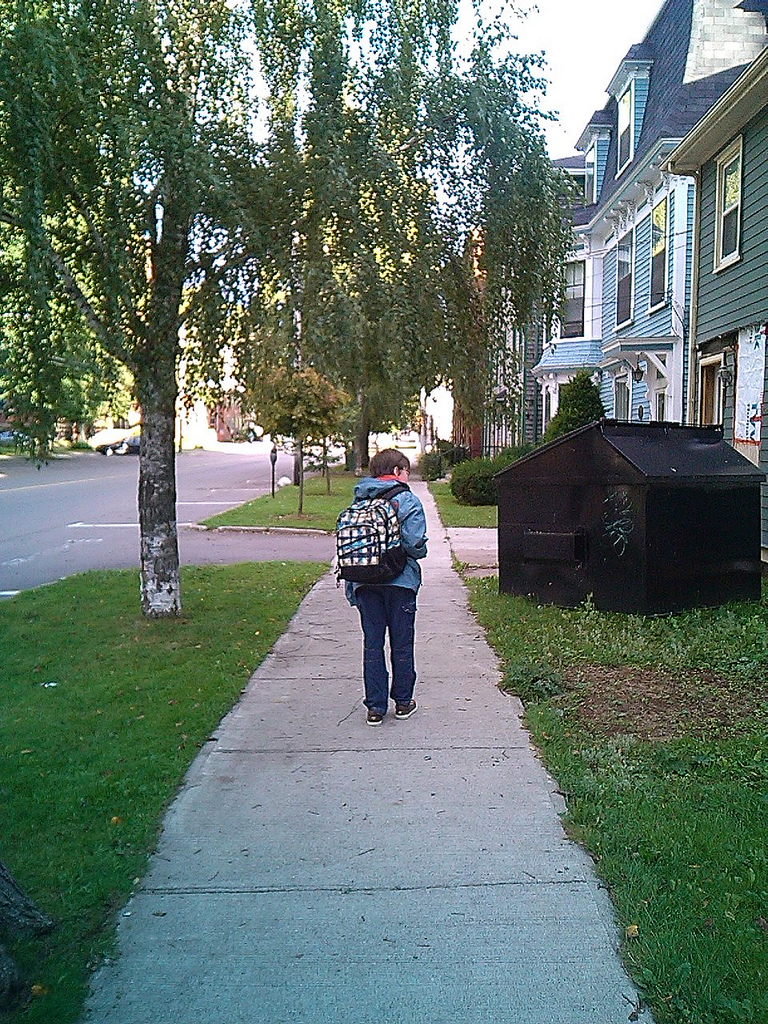
Grade Six, 2012
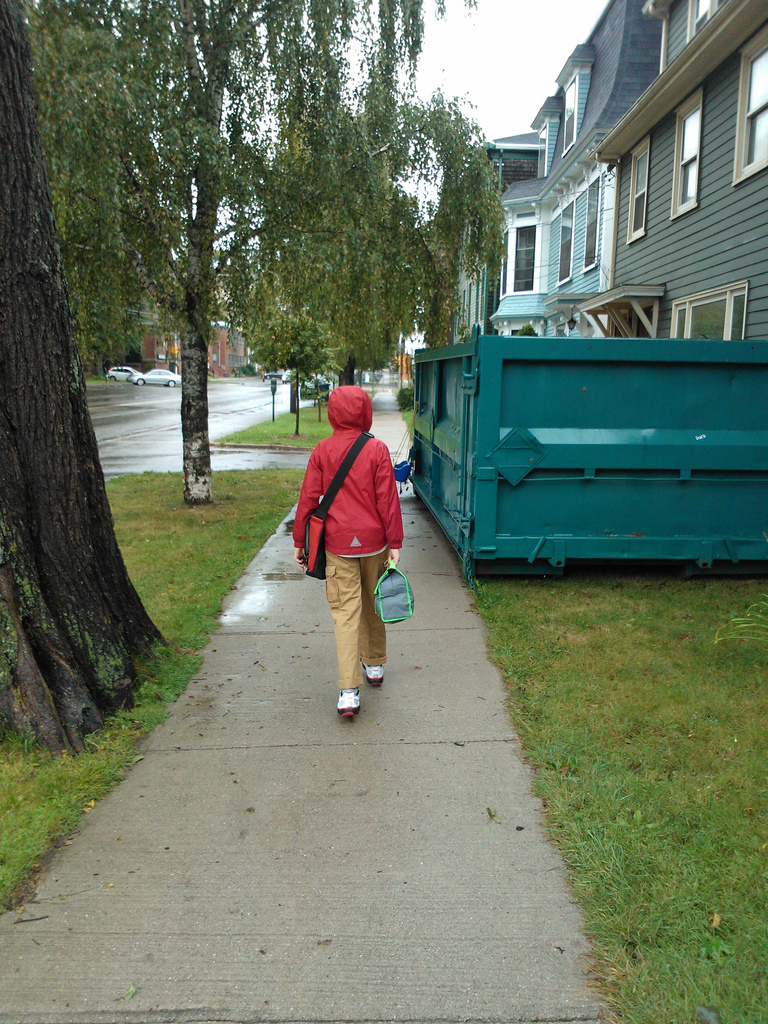
Grade Five, 2011
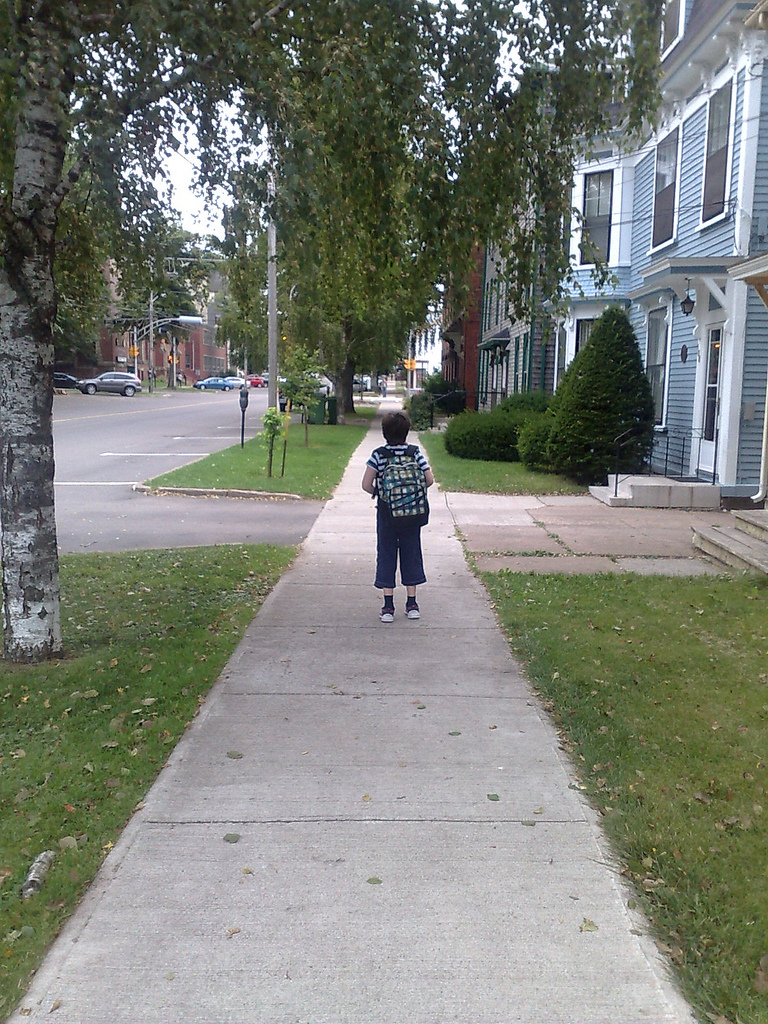
Grade One, 2007
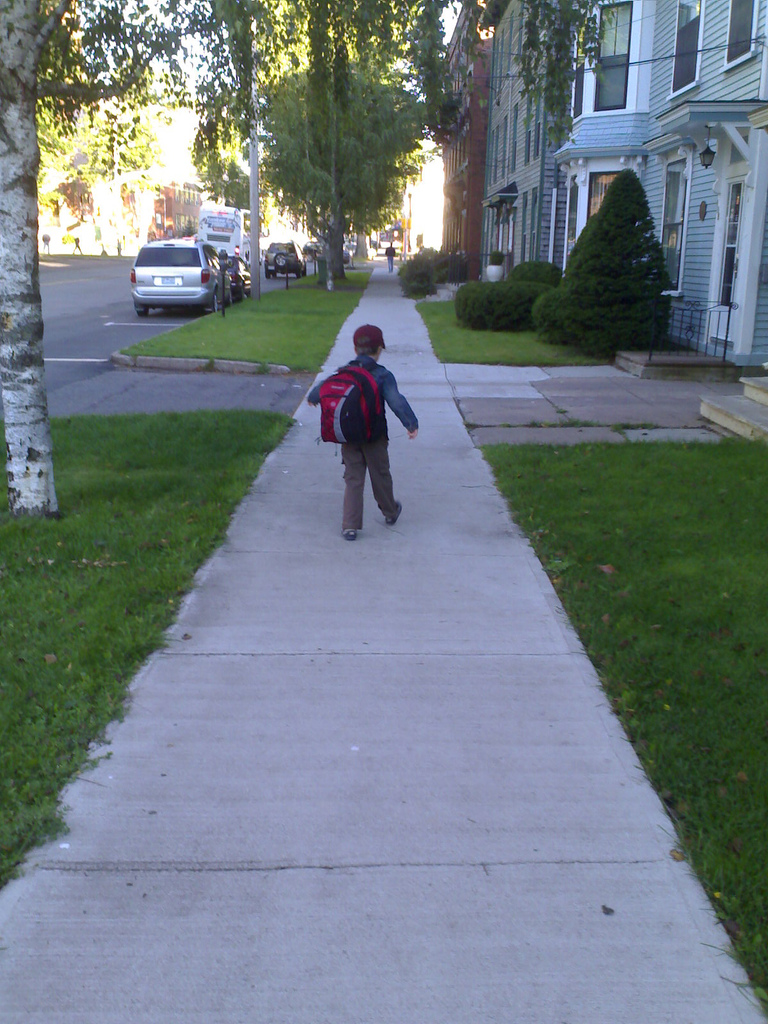
I’ve been turning this idea over in my head all summer long while the maelstrom of Confederation boosterism plays out on every street corner. Someone, I rationed, needs to memorialize the anti-confederates. It’s not a finished concept yet; just a work in progress.

We stopped for coffee at Second Cup in Saint John yesterday. They were promoting their new flat white heavily in the shop, both on the menu, on posters and with a glossy brochure. The brochure goes into some detail to explain what a flat white is, and includes this introductory infographic:
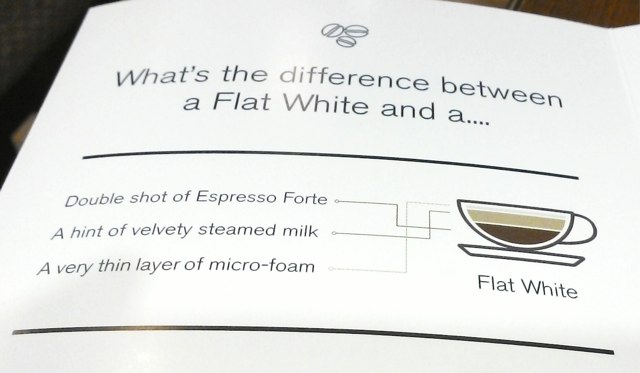
Then, down below, it compares other more-well-known coffees using the same colour scheme:

It’s a good idea, but one that, alas, falls flat because of the decision to use awkward lines to label the flat white’s components, presumably because someone decided that “double shot of espresso forte” had to appear first on the list.
These lines make it much more difficult to parse the infographic and to deduce, at a glance, which colours map to which components. Which, in turn, makes it more difficult to compare the components in the flat white to those in the other coffees.
What could have been an excellent, helpful graphic ends up as something that hurts my head every time I look at it.
Eighteen years ago I headed down to Dublin, New Hampshire for the first time to visit my new colleagues at Yankee Publishing. I made a brief pit-stop at the tourist information centre in St. Stephen, New Brunswick and on the bookshelf there I happened to spy a book about Campobello Island by one Steve Muskie, a book that was notable not for its subject but for its author: Steve was the man at Yankee who’d recruited me, and it was Steve that I was on my way to visit for the first time. Thanks to the book, and its author photo, I now knew what Steve looked like.
Despite my interest being in Steve and not Campobello, in the years since I always had it in the back of my mind that I’d like to visit the island: I’m a sucker for enclaves and so that fact that road access to the island, which is Canadian, requires driving from the U.S. appealed to me. I was also intrigued by the notion that the Roosevelt Campobello International Park was a bi-national project. And I like islands.
And so when it came time to chart our course back from Bethel, Maine to Prince Edward Island, I realized I had my chance, finally: we could drive onto Campobello from Maine, take a ferry to Deer Island, New Brunswick, then another ferry from Deer Island to the New Brunswick mainland, and then reconnect with the highway to PEI.
Which is exactly what we did.
I booked us a last-minute room at the Friars Bay Motel and off we headed on Saturday morning, across the middle of Maine toward the easternmost part of the country.
The drive, along Rte. 219, up the I-95 a little, the along Rte. 1 along the Maine coast, was occasionally very scenic, occasionally very crowded (especially around the turn-off to Bar Harbor, where all New Englanders apparently decided to spend the long weekend), and almost completely lacking in quality coffee.

We arrive on Campobello around 4:00 p.m. after an easy border-crossing with no line-up at all. We checked in at the Friars Bay Motel only to find that a confusion, related to multiple people named “Peter” booking at the last minute, had resulted in a double-booking for our room in the motel. The staff, however, didn’t drop a beat: they had arranged for us to stay in an oceanside house in Welshpool, just up the road, for the same price. Who were we to complain.
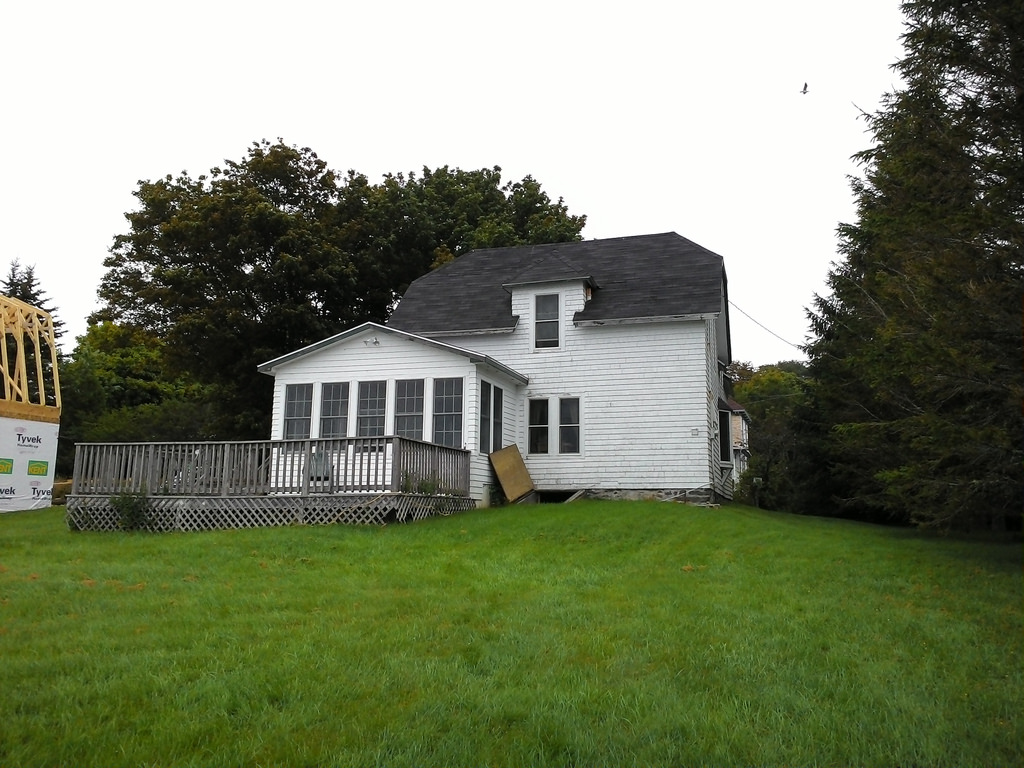
The house was a little musty, but it had three bedrooms, a complete kitchen, a huge living room and dining room, a nice sun porch, a deck, a yard for Ethan to romp around in, and a view to end all views:

We settled in, and then decamped to the Fireside Restaurant, inside the park, for a pleasant supper; on the way back we saw the sun set over America from the beach at Friars Bay:

On Sunday morning we got up early, had a quick breakfast from supplies gathered the night before from the coop grocery store up the road, and then headed to the park for a tour.
My Roosevelt knowledge to this point was weak: I knew about the New Deal, and the war, and about Eleanor as a pioneering feminist, but little else. The visitors centre in the park, along with a tour of Roosevelt Cottage, did an excellent job of bringing us up to speed: the cottage is well-preserved and provides a fascinating look at how the rich summered on the shore, and the staff providing the guided tour were helpful and answered all of our questions.
The highlight of our visit was the Tea with Eleanor program, a free lecture-with-cookies-and-tea, held in the stunning Hubbard Cottage. It lasted about an hour, and consisted of a bottomless cup of King Cole tea, ginger and lemon cookies, and an exploration of the life of Eleanor Roosevelt. The guides told a good story, the tea was strong, and the surroundings perfect.
After tea, we headed back to Welshpool where we caught the 1:00 p.m. ferry to Deer Island ($28 for car and passengers, runs until mid-September, takes about 30 minutes). The ferry is an ingenious combination of barge and tugboat, connected by a device that allows the tug to swing around and change directions. The route affords views of Lubec (in the distance), Eastport and the islands of the area.
Deer Island is nothing to write home about in terms of facilities, but the coastal scenery along the winding 30 minute drive is stunning.
We caught the 2:00 p.m. ferry from Deer Island to the mainland (free, takes 20 minutes), which offers similarly interesting views (although depending on your position on the ferry these can be well-obscured).
These two ferries are two-thirds of the so-called “Quoddy Loop”: we could have doubled back into the USA via the Deer Island to Eastport, Maine ferry (operated by the same company) to “close the loop,” and, indeed, Eastport looks like an intriguing place to visit, in part because of the Tides Institute, so perhaps on our next trip that’s exactly what we’ll do.
Once we hit the mainland we made a beeline from home, stopping briefly in Saint John for coffee (everything was closed except for Second Cup, which turns out to offer an excellent flat white, so we were not disappointed), and in Moncton for supper at Calactus (which is not a great vegetarian restaurant, but it is a vegetarian restaurant in Moncton, which is enough to make it remarkable).
We rolled our rented Fiat 500L into Charlottetown around 9:30 p.m., quickly unloaded, I ran it back to the airport, took a taxi back home, and was in bed by 11:00 p.m.
And so, 18 years after Campobello first came on my radar, I finally got to experience it. It was well worth it, and I’m certain we’ll be back.
We’ve spent the last week here in Bethel, Maine with the gathered Rukavinas: 14 people and one service dog housed in a palatial mansion that far exceeds our station in life (but which, split 5 ways, is surprisingly affordable).
While the details of the intra-familial hijinks that ensured are locked, of necessity, in a vault of secrecy, I can report the following highlights we came across in Metro Bethel:
DiCocoa’s Market Bakery & Cafe, on Main Street downtown, is the local bohemian, dog-friendly, coffee house, serving espresso, intriguing bagels, a wide range of pastries made in-house and offering an eclectic range of local grocery products (kimchi, yogurt, gelato, coffee beans from Larry’s). We had coffee there every day, often-times twice. It’s got a nice vibe, acceptable coffee, and the food is tasty (especially the intriguing bagels). The highlight of our week at DiCocoa’s came tonight, however: the annex next door is opened on occasion for “dining experiences,” and tonight it was Mexican Night, a meal, served family-style, that blew our minds; everything was fresh-picked, locally-sourced, and lovingly made. If you have an opportunity to take in the next offering, I highly recommend you do.
The Good Food Store, on Route 26 heading toward Sunday River, is a nice little healthy grocery store with an array of dry and fresh goods. They have a large selection of dry goods, bread, wine, some frozen entrees that are good for large-group-feeding, and the largest selection of kombucha I’ve ever seen. I learned a lot about by place by eavesdropping on conversation between the cashier and the personable Tucker Carlson while I was waiting in line. There’s a BBQ trailer next door where Catherine and Oliver indulged in various falls-off-the-bone barbeque delights.
Marta’s Bakery, a 30 minute drive south in Waterford, was an unexpected treat. Marta is a Czech baker who serves a lovely array of pastries, accompanied by the best coffee we’ve had on the trip, from her hillside chalet.
The Local Hub, a 30 minute drive east in Greenwood, was described online as a cross between a European bakery, an organic grocery and a yoga studio, and that’s pretty accurate. We stopped for lunch on Wednesday: the food was tasty and the staff exceedingly friendly. Catherine picked up some very nice wool after lunch from the display at the back. Right across the street was a shop selling guns, ammo, Hello Kitty products and origami supplies (which is how you know you’re in Maine when you’re there).
We’re heading back to PEI in the morning, by way of Campobello Island and the ferry to Deer Island, NB, arriving home, if all goes according to plan, on Sunday. This has been the first vacation I’ve had in years that resembled vacations as they are meant to happen: eating, drinking, swimming, relaxing, enjoying the company of family and not working at all. It was oddly pleasant.
Here are some statistics that might interest you about how things have gone since I turned the comments back on here a week ago.
Over the last 7 days there have been 10 comments from real people commenting about real things – “ham” in the spam-fighting game.
During the same 7 days, Mollom, which I am using to filter spam, has stopped 1,421 spam comments.
Two or three pieces of spam are still getting through each day, which I must manually delete: these are usually of the “heap praise” variety of spam, things like “that’s a really great post that I found really great interesting,” with the author’s name linking, because I allowed a “home page” entry on the comment form, to sites selling jeans or sunglasses or domain names or whatever.
These two or three a day are annoying and dispiriting, but I’m a lot better off than I would be deleting 200 spam a day without filtering.
The Australian film Tracks is playing at City Cinema until Sunday night. It’s an interesting film, especially if you are a fan of the “epic solo journeys by indefatigable Australians” genre as I am (see also Half-Safe: Across the Atlantic by Jeep).
Based on the true story of Robyn Davidson, who walked from Alice Springs to the Ocean in 1977, the film is beautifully shot, and an oddly compelling tale, given that the action consists mostly of a woman, a dog and four camels walking across desert landscapes.
There is, I warn you (spoiler alert) dog-related pathos that was especially shocking to me as I had Ethan at my feet throughout; fortunately his head was under the seat of the person in front of me, so he didn’t witness it.
From the article Wrong Answer, published in The New Yorker edition dated July 21, 2014, concerning organized cheating, by teachers and administrators, on standardized tests in Atlanta schools:
John Ewing, who served as the executive director of the American Mathematical Society for fifteen years, told me that he is perplexed by educators’ ”infatuation with data,” their faith that it is more authoritative than using their own judgment. He explains the problem in terms of Campbell’s law, a principle that describes the risks of using a single indicator to measure complex social phenomena: the greater the value placed on a quantitative measure, like test scores, the more likely it is that the people using it and the process it measures will be corrupted. “The end goal of education isn’t to get students to answer the right number of questions,” he said. “The goal is to have curious and creative students who can function in life.” In a 2011 paper in Notices of the American Mathematical Society, he warned that policymakers were using mathematics “to intimidate—to preëmpt debate about the goals of education and measures of success.”
The article referenced is available online – Mathematical Intimidation: Driven by the Data – and is an interesting exploration of the concept of “value-added modeling” in educational testing.
So much of the educational agenda over the last school year was consumed with public discussion of the December 2013 release of PISA test results for the Island – around the Home and School table as much as anywhere else – that it’s helpful to gain context about how testing is conducted, how the results are interpreted and reported, and whether or not they are of value for making practical decisions about educational policy.
For the last 90 days I’ve been running an app called Backtitude on my Android phone that sends my geolocation to a server where it gets stored away in a database.
Backtitude updates my location every 5 minutes, but only if it detects that I’ve moved more than 20 metres, so it’s recorded a total of 4,189 geolocations over 90 days rather than 25,000+ that it would have otherwise.
I built a little web app for myself to visualize my travels: there’s a dot on every location and lines connecting each successive one.
Here’s what my summer – May 21 to August 20 – has looked like so far:
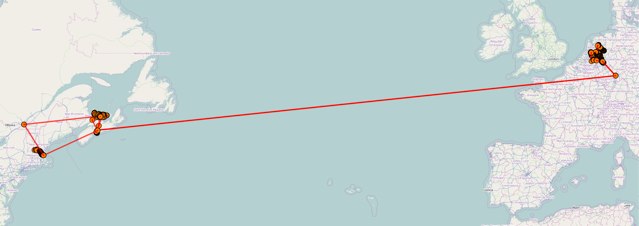
I took a trip to Europe in June and a trip to New England in July: that’s what the long connecting lines are.
The map is more interesting when I zoom in; here’s my travel on the Island, for example: I’ve gone as far west as Ellerslie and and as far east as Cardigan.
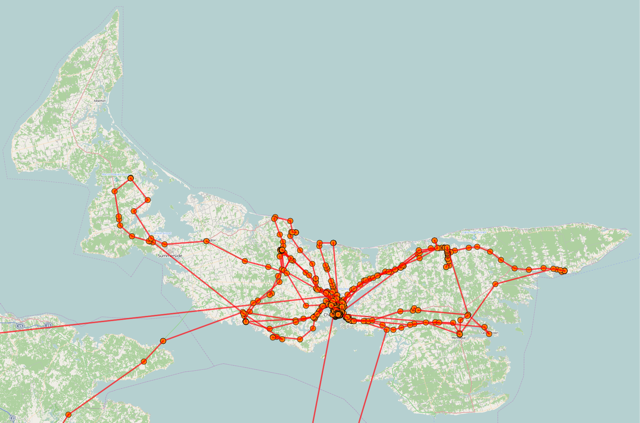
And here’s my summer in Charlottetown, where I spent the most time:

It all becomes more manageable if I decrease the date range that I visualize; here’s the last 24 hours in Charlottetown, for example. Outside of the Richmond Street corridor that connects my house to my office, everything else is dog-walking.
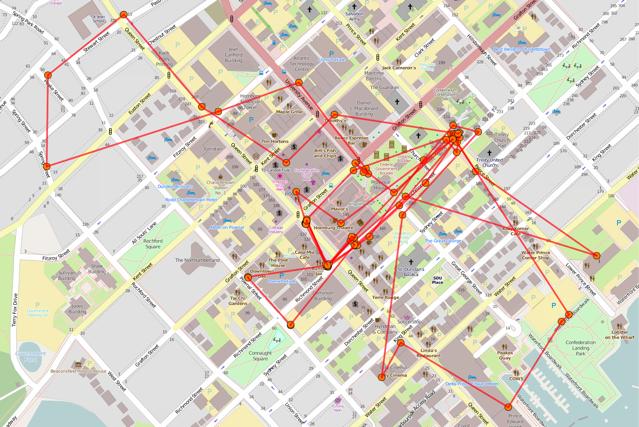
There’s utility both in looking at the overall terrain I’ve covered, but also in looking at specific trips: back in July I decided to follow Waze’s guidance for getting into Logan Airport in heavy traffic. As a result, I blindly drove hither and thither and had no memory of where I’d been. Except that I did:

So I know, as a result, that on July 18 at 4:47 p.m. I was on Rte. 57 between the 128 and Alewife.
And here, earlier in July, is a day-trip into Utrecht in The Netherlands, arriving at the train station, walking through the centre to the Universiteitsmuseum, then a walk uptown for summer before returning to our campground:
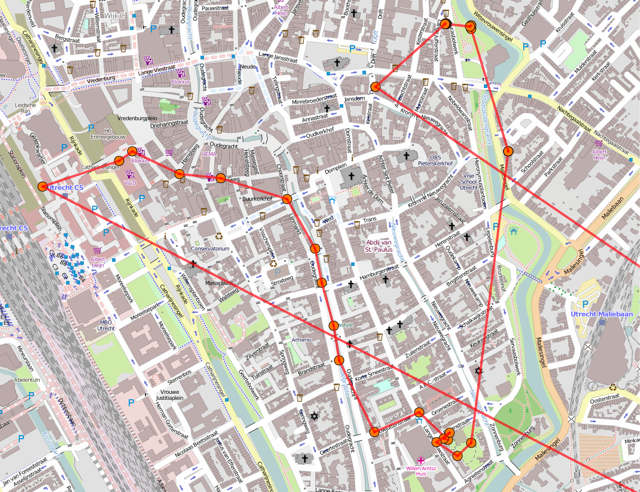
And here’s a walk around the centre of the town of Zaltbommel one afternoon on an open studio tour:
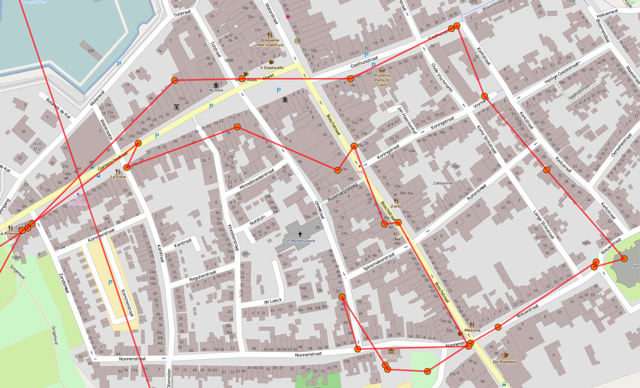
Looking back over the last 90 days my travels are fading from memory far enough that navigating back through my geolocation timeline has an effect similar to flipping through vacation photos. I’ll be interested to experience the same thing once I’ve been tracking my location for, say, a year or two.
If you’re interested in doing the same thing, here’s the server-side code that accepts geolocations from Backtitude.
One of the side-effects of suspending the cross-posting to Facebook that I announced yesterday was that you readers were again left without any way of leaving comments on posts here, something that, once I removed the ability to comment here directly several months ago, Facebook jumped in to fill a vacuum.
While I didn’t want to go back to old-school-spam-embattled commenting, I did want to reintroduce reader comments, and so I migrated the archive of 20,000+ comments stretching back more than 15 years into Disqus, something I dipped a toe in the water of in 2012
Like Facebook, Disqus too is “a commercial somewhere else,” but in this situation I think the utility afforded by Disqus makes this outsourcing worthwhile, at least as an experiment.
So comment-away, dear readers.
And, while you’re at it, revel in your newfound access to comments of yore: the Mac OS X Accounting Software for Canada? post, for example, has 175 of them, many containing really useful information.
Comments on the return of comments – and on the functionality offered by Disqus – are welcome.
Update later in the day: I knew that Disqus was too good to be true. I realized, almost as soon as I started to navigate the web, that the Disqus business model is based on its ability to litter cookies into users browsers tied to content, which is then sold to third parties as a vector for advertising. I noticed this because I was using this post on Transunion to test comments, and all of a sudden all the advertising I was seeing on the web was for Transunion. This kind of thing is precisely why I turned off Google Analytics, another vector for advertising data to leak out of the site, and so reintroducing this through the (otherwise quite handy and functional) Disqus seemed like a step backwards. So, new plan: I’m importing all of the old native-to-Drupal-stored-here-not-elsewhere comments – you’ll find them in place now, albeit rendered in a rather ugly fashion – and I’ll turn back on the ability to add new comments tomorrow. Sorry for the confusion. Lesson learned.
Update the next day: Comments have returned. Proceed as you were.
 I am
I am